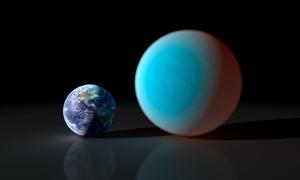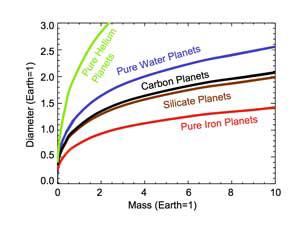Blog
Altered Carbon
25 April 2014
 NASA/JPL-Caltech/R. Hurt
NASA/JPL-Caltech/R. HurtYesterday I talked about the 55 Cancri system, a Sun-like star which has at least four gas giant planets, two of which orbit the star much closer than Mercury in our own system. What I didn’t talk much about is the other known planet in the system, known as 55 Cancri e. It is a super-Earth with a mass about 9 times that of Earth’s. One of the most surprising aspect of this world is that it orbits its star at a distance of about 0.016 AU, which is 1/20th the distance of Mercury from the Sun. It is so close to the star that it is tidally locked, and its star-facing side has a temperature of more than 2000°C. Given its high temperature and proximity to the star, one would expect much of the lighter elements to have boiled off, leaving a rather dense iron-rich world. What we find is that its density is only slightly higher than Earth’s. This means it is likely a new kind of planet.
At the moment we can’t observe any spectra from the planet, so we don’t know for sure what it is made of, or if it has an atmosphere. All we know is its mass, size and orbital characteristics. But a hint lies in an unusual property of the star, specifically that it has much more carbon than our Sun. Assuming the planets have a similar composition, this could mean that this particular super-Earth could be a carbon planet. Such planets are sometimes referred to as diamond planets, partly because they could have diamond-laden mantles, but mainly because “diamond planet” sounds cooler than “carbon planet.”
 Marc Kuchner/NASA GSFC
Marc Kuchner/NASA GSFCGiven that Earth is teeming with carbon-based life, you might think Earth is a carbon planet. But in fact, carbon makes up less than a tenth of a percent of Earth’s bulk. Most of the planet is oxygen and silicon, which is evidenced by the fact silicates make up about 90% of the Earth’s crust. A carbon planet would likely have an iron core like Earth, but instead of silicates it would consist of oxygen-carbon compounds. So it would likely have a crust of graphite, diamond and carbonate minerals. Carbon planets would also likely lack water, since carbon bonds so well with oxygen there would likely be little left to bond with hydrogen to form water.
The density of 55 Cancri e matches theoretical calculations for a carbon planet. So that seems like a good possibility. The planet is not dense enough to be a silicate planet like Earth, and other solutions such as water-ice seem unlikely given its high temperature.
Planets like 55 Cancri e are among the first to demonstrate that the composition of a planetary system depends critically on the composition of its star. We like to imagine that exoplanets are similar to planets in our own system. We even categorize them as “Earth-like” or “Jupiter-like”. But it is very likely that these worlds are far more alien than we expect.